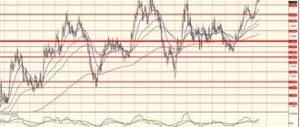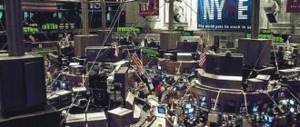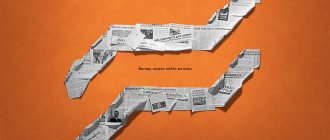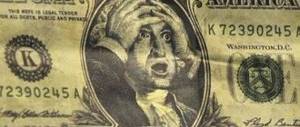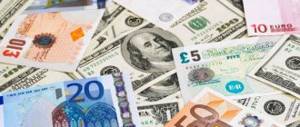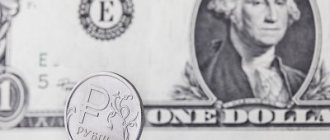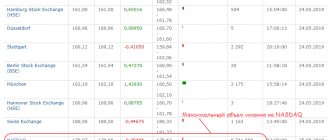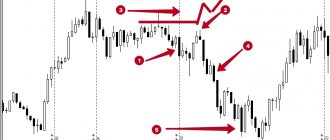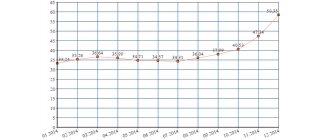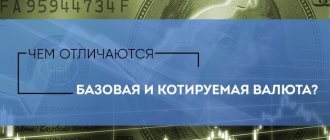We continue our series of publications on the principles of formation of exchange rates and in this article we will take a detailed look at how exactly the exchange rate of the dollar and euro to the Russian ruble is formed on the main trading platforms. In Russia, the exchange rate of the dollar and euro to the ruble is determined in exchange conditions, on the Moscow Exchange. During the period of Russia’s existence after the collapse of the USSR, this process has experienced significant changes and transformations, which is why many citizens may still be confused about who plays what role in the country’s main foreign exchange market. Naturally, in addition to the main rate that the Central Bank publishes, there are others, even more interesting for the common population: rates on the black market and at bank cash desks. Let's consider the main points related to the formation of the exchange rate in Russia.
A little history
Until the thirties of the last century, the so-called gold standard operated in most countries. According to him, the gold content was established in the currency. Governments were required to exchange their currencies for gold. To support the system, a strict relationship was introduced between the money supply within the country and its gold reserves. Their courses were formed according to the gold content. For example, one US dollar was worth twenty-three point twenty-two grains of gold, and one English pound was worth one hundred and thirteen grains, that is, four point eighty-seven hundredths times more. Based on these calculations, the exchange rate was determined, where one pound equaled 4.87 dollars.
Exchange rate
Every bank visitor saw a colorful board inside the office (and outside it) with currency purchase/sale rates, which can change up to several times a day.
The purchase rate is the price at which the bank is ready to accept foreign currency from the population.
The selling rate is, accordingly, the price at which an institution sells a specific currency.
The purchase rate is always lower than the sale rate - it is from this difference that the bank earns through exchange transactions with currency. If you can’t figure out what the exchange rate is, then follow a simple rule: where the value of the currency is lower, that means that’s what the bank buys it for.
There are no instructions from the Central Bank regarding the establishment of buying and selling rates by banks - it does not regulate the use of official rates of foreign currencies in relation to the ruble and does not determine the scope of their mandatory application. No regulatory document regulates this procedure. A banking institution focuses primarily on the general market situation. If it sets the selling price higher than that of its competitors, it is unlikely that anyone will buy this currency, so the rates in different banks are approximately the same. Thus, the main “regulator” of the exchange rate is the retail market for the sale and purchase of currency to citizens (individuals).
Indicators of supply and demand for a particular currency also play a role in determining the exchange rate. So, if the value of a certain currency is rapidly falling and the population is in a hurry to say goodbye to it, the purchase rate will invariably decline. It’s the same story with an increase in the market rate - its growth will certainly cause an increase in the selling price.
The level of the exchange rate is also influenced by such an indicator as the currency position of a financial institution, i.e. the ratio of obligations and claims of a commercial bank in foreign currency. If a bank needs the currency of a certain country, its purchase rate may rise. If there is an excess of foreign monetary units and the bank wants to “unload” from it, the selling rate will be set lower than the market average.
The difference between the selling and purchasing prices of foreign currency is called the “spread”. So, any bank, when determining its pricing policy for currency exchange, will always strive to increase the spread and, accordingly, its income.
All the nuances described above collectively affect how banks set rates for the sale and purchase of currencies.
Floating exchange rate system
How are exchange rates formed? In the seventies, the gold and exchange rate system was replaced by a system of floating exchange rates. Its meaning lies in the formation of exchange rates due to the relationship between supply and demand, like securities on the stock exchange. However, the exchange rate did not become completely free. When a certain limit was reached, the state had parity (as in Europe since 1979), and the country's Central Bank, coordinating its actions with other countries, officially changed course. If the change was downward, then revaluation took place, and if it increased, devaluation took place. The limit was reached with changes of a few percent, but in the nineties it increased to fifteen percent.
Revaluation and devaluation are not the only ways the state intervenes in the process that explains how exchange rates are formed. To avoid strong fluctuations, they introduce so-called currency interventions, where, if the exchange rate falls, they buy it, and if on the contrary, they sell it.
The mechanism is not always successful, since the owners of the national currency located abroad do not obey the instructions of their governments. For example, if the US raises its lending rate, the lending rate for non-US currencies remains the same, making them more attractive.
At what amounts is it profitable to buy currency on the exchange?
Buying $1 on the stock exchange is not profitable: the dollar itself will cost 75 kopecks cheaper than in the bank, but you will have to pay a commission: 1 ₽ to the Moscow Exchange and also, for example, 1 ₽ to the broker. In this case, we remain in the red - we lose 1.25 rubles.
When buying $3, we are already in the black by 25 kopecks: on the difference in rates we save 2.25 ₽ minus 2 ₽ commission.
These are calculations for cases when there is no commission for withdrawing currency from a brokerage account to a bank account. If your tariff includes it, you also need to take it into account in order to understand where it is more profitable to buy currency - in a bank or on an exchange.
General factors influencing the formation of exchange rates
How the exchange rate is formed on the stock exchange, in banks and in states in general.
- Export and import. The higher the prices in the country compared to foreign prices, the greater the imports will be. Thus, the price of foreign currency will be high.
As income increases, the demand for imports will increase, which will cause the national currency to depreciate.
On the other hand, when national income is high abroad, the price of foreign currency decreases.
- Movement of capital. When an investor desires to obtain more foreign cash, deposits, stocks, bonds and liabilities, the price of foreign currency increases.
On the other hand, payments to a state strengthen the value of its currency.
- Data output and waiting for data output. Such data includes: publication by host countries of economic indicators, statements on changes in interest rates, reviews of economic conditions, and others.
- Activities of funds. Funds have a huge impact on the movement of exchange rates when investing in certain currencies. They have great resources that can force the course to move in any direction.
- Activities of exporters and importers. They are users of the foreign exchange market interested in selling and buying foreign currency. However, this impact is insignificant and short-term, because the volume of their foreign trade transactions is negligible in comparison with the total volume of transactions in the foreign exchange market.
- Statements by politicians. At various meetings, summits, press conferences, and so on, such speeches are closely monitored online, after which the foreign exchange market immediately reacts depending on the strength of the statements.
Everyone remembers the end of 2014, when Russian President V.V. Putin, with one speech, instantly stabilized the ruble exchange rate (“the exchange rate started talking”), thus stopping its rapid decline.
- Activities of central banks. The mechanism of its influence is described below.
National Clearing Center at the Center of Everything
The Moscow Exchange has a very important subsidiary. It is he who regulates the physical process of trading on the stock exchange, including currency exchange. In particular, the clearing room, which services all transactions carried out under exchange trading conditions. That is, simply put, when one bank places an order to buy a dollar, and another to sell, the exchange does not take place between these two banks. First, one bank gives dollars to the NCC, then the NCC sells these dollars to the buying bank, after which it transfers the rubles proceeds from the sale to the selling bank.
In addition to intermediation, the Clearing Center also performs a very important function of determining key performance indicators of the foreign exchange market. In particular, using methods approved by the management of the Moscow Exchange, he:
- Determines the upper and lower boundaries of the price corridors of currency pairs traded on the exchange
- Conducts regular fixing, that is, establishing the current weighted average rate of currency pairs
- Calculates risk parameters for trading on the currency exchange
We will not go into specific calculations, since the financial mathematics used by NCC is quite complex. Let's just say the basic principle: the clearing center directs efforts to curb volatility and prevent too sharp, sudden changes in the foreign exchange market. In particular, there are certain technical restrictions that do not allow bidders to increase the price too sharply.
central bank
Let's consider how the exchange rate of the Central Bank is formed.
The influence of states on the foreign exchange market is exercised through central banks. As already noted, it is extremely rare to encounter a situation where the state does not interfere at all in currency exchange operations (a free-floating state). As a rule, from time to time they affect the exchange rate (the state of dirty floating), thus influencing how the exchange rate of the Central Bank is formed.
In the interests of production and consumption, states carry out direct and indirect regulation. Direct regulation takes place with discount policy and foreign exchange interventions. Indirect regulation is carried out through the level of inflation, the amount of money in circulation, etc.
Course for tomorrow and previous days
| date | Central Bank rate, rub | Change, RUR | Change, % |
| 05/17/2021, Mon | 73.9968 | — | — |
| 05/18/2021, Tue | 73.8537 | -0.1431 RUR ▼ | -0.19% ▼ |
| 05/19/2021, Wed | 73.6992 | -0.1545 RUR ▼ | -0.21% ▼ |
| 05/20/2021, Thu | 73.6778 | -0.0214 RUR ▼ | -0.03% ▼ |
| 05/21/2021, Fri | 73.6007 | -0.0771 RUR ▼ | -0.1% ▼ |
| 05/22/2021, Sat | 73.5803 | -0.0204 RUR ▼ | -0.03% ▼ |
| 05/23/2021, Sun | 73.5803 | — | — |
| 05/24/2021, Mon | 73.5803 | — | — |
| 05/25/2021, Tue | 73.5266 | -0.0537 RUR ▼ | -0.07% ▼ |
| 05/26/2021, Wed | 73.3963 | -0.1303 RUR ▼ | -0.18% ▼ |
| 05/27/2021, Thu | 73.4737 | +0.0774 RUR ▲ | +0.11% ▲ |
See also:
- Dollar exchange rate for the whole of 2021
- Dollar exchange rate for the whole of May 2021
TSB RF
Further on how the currency exchange rate of the Central Bank of the Russian Federation is formed.
Every day, except weekends, the Central Bank of the Russian Federation sets exchange rates for most currencies to the ruble. The dollar against the ruble is determined based on how trading went the day before on the Moscow Interbank Currency Exchange. The same applies to the euro. The remaining currencies are formed through cross rates, that is, the relationship between the ruble and another currency, based on the relationship to the dollar.
The way the currency exchange rate of the Central Bank of the Russian Federation is formed is also influenced by imports and exports. If more goods are sold than purchased, it will be better for the national currency to fall in price, and vice versa.
The Central Bank sets the exchange rate for more than thirty types of currencies. These are dollar, euro, yuan, franc, yen, hryvnia and others.
Since 2005, the Central Bank of the Russian Federation has switched to a dollar-euro bi-currency basket. It is believed that in this way more flexible regulation is achieved and an increase in volatility is realized. The rate is calculated from the ratio of the dollar-euro currency pair on the Forex markets and the ruble versus euro quotations on the MICEX.
Who uses the USD rate for tomorrow
Let's start with the fact that the official exchange rate of the Central Bank of the Russian Federation is not used by banks, exchange offices and other commercial companies to exchange currency for rubles or other transactions. As a guide, such organizations use the previously mentioned MICEX exchange, on which the value of the US dollar changes throughout the day.
Therefore, if you are interested in the current price of the dollar online, we recommend using the Forex exchange rate, which also receives information about USD/RUB trading from the MICEX. If you are interested in the price of the American dollar to find the optimal rate for subsequent exchange at a bank in your city, visit a special section on our website.
As for the official dollar exchange rate set by the Central Bank for tomorrow, the main users are government agencies, such as the NSF, customs, Ministry of Finance, etc. Such organizations need to know in advance the fixed value of the currency for the next day for use throughout the next day.
— What is the supply of foreign currency in the country formed from?
_________
Export foreign exchange earnings of exporting companies (in the Russian Federation this is, first of all, income from the sale of raw materials: gas, oil, etc.). Other companies and citizens can also sell their accumulated currency. Foreign investors sell foreign currency in order to purchase local currency and invest it in real investment projects in the country. Investors lend to local companies and banks in currency, which also ends up on the foreign exchange market.
Speculators invest money for short periods - from several days to several months. This is the so-called “hot money”. They make money on the difference in currency returns in different countries. For example, in Russia the yield in 2015 was 10-15%, and in Europe and the USA less than 1%. Speculators borrow money at low rates abroad, convert it into rubles and invest it in high-yield financial instruments (local bonds, stocks, deposits) in Russia.
Speculators closely monitor the market situation and withdraw money at the first sign of destabilization. The ruble asset is sold and the rubles are converted back into foreign currency. For them, the scenario of a sharp devaluation of the ruble is unfavorable, because the loss on the exchange rate will eat up their profits from the higher interest.
You may like the article “Forex exchange rates in real time”
________
— What forms the demand for foreign currency?
________
Exchange rates are determined by supply and demand. Currency is also a commodity and its price is determined by the demand for it. If a product is in short supply, its price increases.
Currency is needed for the purchase of goods and services abroad by importing companies and citizens of the country. Currency is required to repay previously taken loans in foreign currency. Currency is also used as a store of value by citizens, companies and government agencies. In Russia, the Central Bank has the largest stash of foreign currency (more than $300 billion). Of course, currency is also purchased for investment abroad and the withdrawal of capital from the country by investors, speculators and citizens.
You might be interested in the article “Live Forex Chart”
________
How does the Central Bank influence the yuan exchange rate?
It will be useful for you to know that in China the central bank is called the people's bank. Relatively recently, the central bank of China decided to reduce the yuan quotes to the lowest level observed over the past 12 years. The main reason for this decision is the ongoing trade war between the US and China. In the current situation, a cheap yuan will help offset the consequences caused by the introduction of tariff restrictions by the United States. With a cheaper yuan, Chinese manufacturers will be able to increase export volumes, which will support the local economy, which is weakening due to the trade war.
The decline in the value of the yuan will also have a positive impact on domestic policy. Since the Chinese central bank plans to reduce the discount rate to reduce the value of the yuan, this will make loans for local producers much more accessible. Thanks to cheap loans, we can expect another growth in the Chinese economy.
How does the Central Bank influence the euro exchange rate?
It will be useful for you to know that the Central Bank of the European Union is currently also thinking about introducing a negative discount rate. It should be noted that the chances of such a decision being made are quite small. This is due to the fact that in such a scenario, the income of commercial banks operating in the EU will be seriously reduced, which will have a negative impact on the financial system of the entire European Union.
Despite the fact that the EU is experiencing quite serious difficulties caused by the coronavirus pandemic, the central bank of the European Union does not intend to reduce stimulation of the economies of member countries. Only after measures to stimulate the EU economy are announced will it be possible to draw any conclusions about the future of the euro. If, as a result of the measures taken, the volume of money supply in the eurozone increases, then we can expect a fall in euro quotations.
